I have a function which turns on a LED by setting PB1 to HIGH. The light from the LED is barely visible. If I set PB1 to HIGH in my main function the light from the LED is as bright as it should be.
It makes no sense to me since it's just changing a value, which is either 0 or 1. I must be missing something extremely obvious, but what could it be?
Here's some background information:
- The LED is connected in series with a resistor so it's not being shorted
- I have tried the two different codes attached multiple times to make sure the problem is reproduced every time
- I have tried to use a different pin to rule out that there is something wrong with that specific pin
Edit: Added some more information and tags
- Chip: ATmega328-PU
- Programmer: AVRisp MKII
Here's the code with the pin set in main:
#include <avr/io.h>
int main(void) {
DDRB |= (1 << PB1);
PORTB |= (1 << PB1);
while(1) {
}
return 0;
}
And here's the code where the pin is set in a function:
#include <avr/io.h>
void turn_on_led();
int main(void) {
DDRB |= (1 << PB1);
turn_on_led();
while(1) {
}
return 0;
}
void turn_on_led()
{
PORTB |= (1 << PB1);
}
Here is the makefile:
main:
avr-gcc -g -Os -Wall -mmcu=atmega328 -c ../src/example.c
elf:
avr-gcc example.o -o example.elf
hex:
avr-objcopy -O ihex example.elf example.hex
dump:
avr-objdump -h -S example.o > example.lst
upload:
avrdude -p m328 -c avrispmkII -P usb -U flash:w:example.hex
clean:
rm -f *.o
rm -f *.hex
rm -f *.lst
Fuse setting:
avrdude: Device signature = 0x1e9514
avrdude: safemode: lfuse reads as E2
avrdude: safemode: hfuse reads as D9
avrdude: safemode: efuse reads as 7
Fuse setting input in a fuse calculator to show individual bits:

Disassembly of setting pin in main:
example.o: file format elf32-avr
Sections:
Idx Name Size VMA LMA File off Algn
0 .text 00000006 00000000 00000000 00000034 2**0
CONTENTS, ALLOC, LOAD, RELOC, READONLY, CODE
1 .data 00000000 00000000 00000000 0000003a 2**0
CONTENTS, ALLOC, LOAD, DATA
2 .bss 00000000 00000000 00000000 0000003a 2**0
ALLOC
3 .debug_abbrev 0000004e 00000000 00000000 0000003a 2**0
CONTENTS, READONLY, DEBUGGING
4 .debug_info 00000082 00000000 00000000 00000088 2**0
CONTENTS, RELOC, READONLY, DEBUGGING
5 .debug_line 000000c2 00000000 00000000 0000010a 2**0
CONTENTS, RELOC, READONLY, DEBUGGING
6 .debug_frame 00000020 00000000 00000000 000001cc 2**2
CONTENTS, RELOC, READONLY, DEBUGGING
7 .debug_pubnames 0000001b 00000000 00000000 000001ec 2**0
CONTENTS, RELOC, READONLY, DEBUGGING
8 .debug_pubtypes 0000001e 00000000 00000000 00000207 2**0
CONTENTS, RELOC, READONLY, DEBUGGING
9 .debug_aranges 00000020 00000000 00000000 00000225 2**0
CONTENTS, RELOC, READONLY, DEBUGGING
10 .debug_str 000000d9 00000000 00000000 00000245 2**0
CONTENTS, READONLY, DEBUGGING
Disassembly of section .text:
00000000 <main>:
#include <avr/io.h>
int main(void) {
DDRB |= (1 << PB0);
0: 20 9a sbi 0x04, 0 ; 4
PORTB |= (1 << PB0);
2: 28 9a sbi 0x05, 0 ; 5
4: 00 c0 rjmp .+0 ; 0x6 <__zero_reg__+0x5>
Disassembly of setting pin in function:
example.o: file format elf32-avr
Sections:
Idx Name Size VMA LMA File off Algn
0 .text 0000000c 00000000 00000000 00000034 2**0
CONTENTS, ALLOC, LOAD, RELOC, READONLY, CODE
1 .data 00000000 00000000 00000000 00000040 2**0
CONTENTS, ALLOC, LOAD, DATA
2 .bss 00000000 00000000 00000000 00000040 2**0
ALLOC
3 .debug_abbrev 00000061 00000000 00000000 00000040 2**0
CONTENTS, READONLY, DEBUGGING
4 .debug_info 00000096 00000000 00000000 000000a1 2**0
CONTENTS, RELOC, READONLY, DEBUGGING
5 .debug_line 000000dc 00000000 00000000 00000137 2**0
CONTENTS, RELOC, READONLY, DEBUGGING
6 .debug_frame 00000030 00000000 00000000 00000214 2**2
CONTENTS, RELOC, READONLY, DEBUGGING
7 .debug_pubnames 0000002b 00000000 00000000 00000244 2**0
CONTENTS, RELOC, READONLY, DEBUGGING
8 .debug_pubtypes 0000001e 00000000 00000000 0000026f 2**0
CONTENTS, RELOC, READONLY, DEBUGGING
9 .debug_aranges 00000020 00000000 00000000 0000028d 2**0
CONTENTS, RELOC, READONLY, DEBUGGING
10 .debug_str 000000e5 00000000 00000000 000002ad 2**0
CONTENTS, READONLY, DEBUGGING
Disassembly of section .text:
00000000 <turn_on_led>:
return 0;
}
void turn_on_led()
{
PORTB |= (1 << PB1);
0: 29 9a sbi 0x05, 1 ; 5
}
2: 08 95 ret
00000004 <main>:
#include <avr/io.h>
void turn_on_led();
int main(void) {
DDRB |= (1 << PB1);
4: 21 9a sbi 0x04, 1 ; 4
turn_on_led();
6: 0e 94 00 00 call 0 ; 0x0 <turn_on_led>
a: 00 c0 rjmp .+0 ; 0xc <main+0x8>